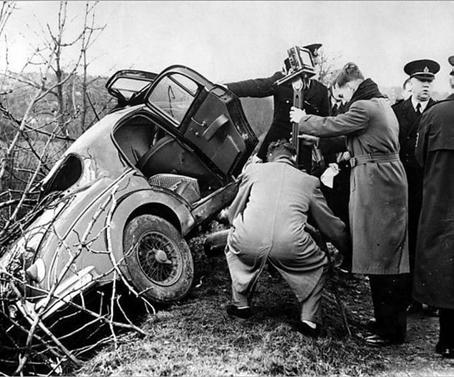
4 minute read
JDHT - On this Day (January
On 22 January 1959 Mike Hawthorn, who raced for Jaguar and was the first British Grand Prix champion, was killed while driving on the Guildford bypass. Mike Hawthorn lead the Jaguar Works Team for the 1955-56 season. In 1955 Mike won the 24 Hours of Le Mans in D-type 774 RW, but was haunted by his involvement in the disastrous crash that killed over 80 spectators and injured hundreds more. He became the United Kingdom’s first Formula One World Champion driver in 1958, whereupon he announced his retirement, On 22 January 1959, only three months into his retirement, Hawthorn died in a car accident while driving his comprehensively modified 1958 Jaguar 3.4-litre saloon VDU 881 to London. While the circumstances of the accident are well documented, the precise cause remains unknown Though he had a short career from first race to World Champion in six seasons and died young, Mike Hawthorn is still remembered as one of the greatest racing drivers. .
Mike Hawthorn’s crashed Mk I. He died from fatal head injuries 22 January 1959


This SS Jaguar 100 has had a fairly busy life. It was built on 20 January 1938, the 29th 2½ litre one made and despatched on the 4th February. Originally painted in black with brown interior it was raced on a variety of occasions throughout 1939 by its second owner: In the 1950s it was acquired by Walter Elliott, from a local farmer by which time it had changed colour from black to cream. He had many years of fun touring Europe in what he believed was the ‘Super Car of the Day’ It then went through a few more owners before being acquired by Mr G Priest in 1968 who undertook a fairly comprehensive restoration from 1968 through to the early 1970s. This included not just mechanical work but also paintwork including its second change of colour, from cream to red and the upholstery was refurbished, changing from brown to black. Jaguar Cars bought ERB 290 from Mr Priest in 1984 to add to its collection of historic cars in the ownership of the Jaguar Daimler Heritage Trust. The Science Museum operated PRISM fund contributed £10,000 towards this purchase. Once in the ownership of the JDHT the car underwent some minor recommissioning work in 1994 and has been maintained as a running, driving vehicle since then. .

On 20 January 1938 The Trust’s 1938 SS100 2.5 litre, ERB 290, was built.
Harry Mundy In 1927, an Austin (1915–1988) was a Seven chassis was British car engine obtained by Sir designer. William Lyons After World War II he moved to British Racing Motors (BRM) in 1946 as head of the design office, through a dealer in Bolton, and in May of that year, the first Swallow Sidecar motor car was produced. being involved in The plan was to the design of the fit the car with a BRM V16 Formula detachable folding One engine, before hard top, but moving on again in this proved to be 1950 to Coventry impractical, and the Climax engines cycle-type wings as chief designer of the first car also On 15 January 1964 Harry Mundy joined working on the had to be changed Jaguar as Chief Development Engineer. FWA engine. to ordinary flowing His career took a change and he moved into journalism wings. becoming Technical Editor of The Autocar magazine in 1955, On 18th January 1928, Lyons was given a contract by the but while there he also worked on the design of the Ford based London motor trader Henlys for no less than 500 Austin Seven twin-cam engine for Lotus. Swallows – at the rate of twenty-five per week. Following Jaguar's purchase of Coventry Climax in 1963, his However, the maximum number that could be built in the friend and former work colleague Walter Hassan persuaded Blackpool factory was fourteen cars per week. The consequence Mundy to return to engineering where, with William Heynes, was that Lyons decided to move his company to new premises they developed the Jaguar V12 engine. Harry Mundy went on to develop the “Advanced Jaguar SixCylinder” or “AJ6” engine before his retirement in 1980, after which he still did some consultancy work. . in Coventry, in the heartland of the motor industry, and the move took place in November 1928. The rest is history. .

On 18 January 1928 Herbert ‘Bertie’ Henly and his business partner Frank Hough of Henlys in London, signed an agreement with William Lyons for 500 Austin Swallows.









